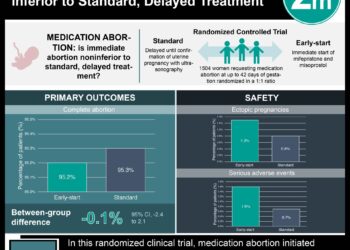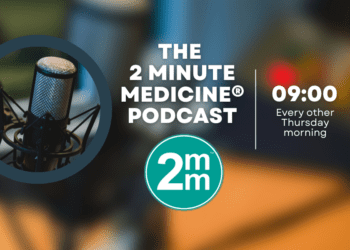Travel time to abortion facilities in the United States significantly increased after the Dobbs v Jackson Women’s Health Decision
1. Travel time to abortion facilities was significantly increased after the landmark trial Dobbs vs. Jackson Women’s Health in states where abortions were prohibited or limited to under 6 weeks, compared to before this ruling.
2. A third of American women of childbearing age are estimated to live more than one hour’s drive from the nearest abortion facility.
Level of Evidence Rating: 2 (Good)
Study Rundown: The right to abortion is one of the most controversial topics today in the American political landscape. In June 2022, a landmark Supreme Court trial (Dobbs v Jackson Women’s Health) upheld the ruling that there would be no guarantee of abortion access from federal health legislation, meaning that lawmakers in individual states were free to restrict abortion access as they saw fit. Since then, complete or partial bans on abortion access have been enacted in at least 15 states. The present study sought to evaluate the impact of this change in legislation at the individual level by assessing access to abortion facilities for women of reproductive age in the United States before and after the Dobbs legislation was enacted.
A total of 1134 abortion facilities were active in the United States in the pre-Dobbs era, and 78 were inactive across 15 states in the post-Dobbs era. In the pre-Dobbs era, abortion facilities were active in every state, although 6 states only had a single facility available. The median travel time to an abortion facility was 10.9 minutes, and the mean time was 27.8 minutes. In the post-Dobbs era, the median travel time was 17.0 minutes, and the mean travel time was 100.4 minutes. This increase in travel time was statistically significant. There was geographic variation in the change to travel time observed, with Southern states largely affected, such as Texas and Louisiana. This analysis also demonstrated that communities more than 60 minutes from an abortion center in the post-Dobbs area tended to be lower-resourced.
This impactful study by Rader et al. illustrates the devastating impact of the Dobbs legislation of 2022 on access to abortion care in much of the United States. Travel time to abortion facilities was globally increased and disproportionately affected individuals from low-resource communities. A primary limitation of this work is that it assumes equal access to transportation across the population, whereas financial and other barriers to access exist. However, this work is incredibly important in characterizing the ground-level impacts of restricting reproductive rights and can act as a point of reference for healthcare advocates to understand where this population is most vulnerable.
Click here to read this study in JAMA
Relevant reading: Socioeconomic outcomes of women who receive and women who are denied wanted abortions in the United States
In-Depth [cross-sectional study]: A cross-sectional geographic analysis was completed at two points in time: the pre-Dobbs period (January-December 2021) and the post-Dobbs period (September 2022). The primary outcome was the proportion of reproductive-age females living more than 60 minutes away from an active abortion facility within the mainland United States. Records from all abortion-providing facilities were examined through the Advancing New Standards in Reproductive Health database. Travel time was estimated using a previously validated algorithm for geographic analysis.
The median travel time to an abortion facility in the pre-Dobbs era was 10.9 minutes (interquartile range 4.3-32.4 minutes). The mean travel time was 27.8 minutes (standard deviation 42.0 minutes). An estimated 14.6% of reproductive-aged females lived more than an hour away from an abortion facility. In the post-Dobbs era, the median travel time was 17.0 minutes (4.9-124.5), and the mean travel time was 100.4 minutes (161.5 minutes). This increase in travel time was statistically significant using the paired t-test (P<0.001). 33.3% of the study population lived more than an hour from an abortion facility in the post-Dobbs era.
In a sensitivity analysis of patients in select states where abortions after 15 weeks were inactive, 42.7% of reproductive-aged females lived more than an hour away from an abortion facility. States that were amongst the most significantly affected included Texas and Louisiana, where the increase in mean travel time was 432.2 minutes (172.4) and 420.3 minutes (51.9), respectively. Residents in census tracts more than 60 minutes travel time to an abortion facility in the post-Dobbs area were significantly less likely to have health insurance, a high school diploma or home internet access.
Image: PD
©2022 2 Minute Medicine, Inc. All rights reserved. No works may be reproduced without expressed written consent from 2 Minute Medicine, Inc. Inquire about licensing here. No article should be construed as medical advice and is not intended as such by the authors or by 2 Minute Medicine, Inc.







